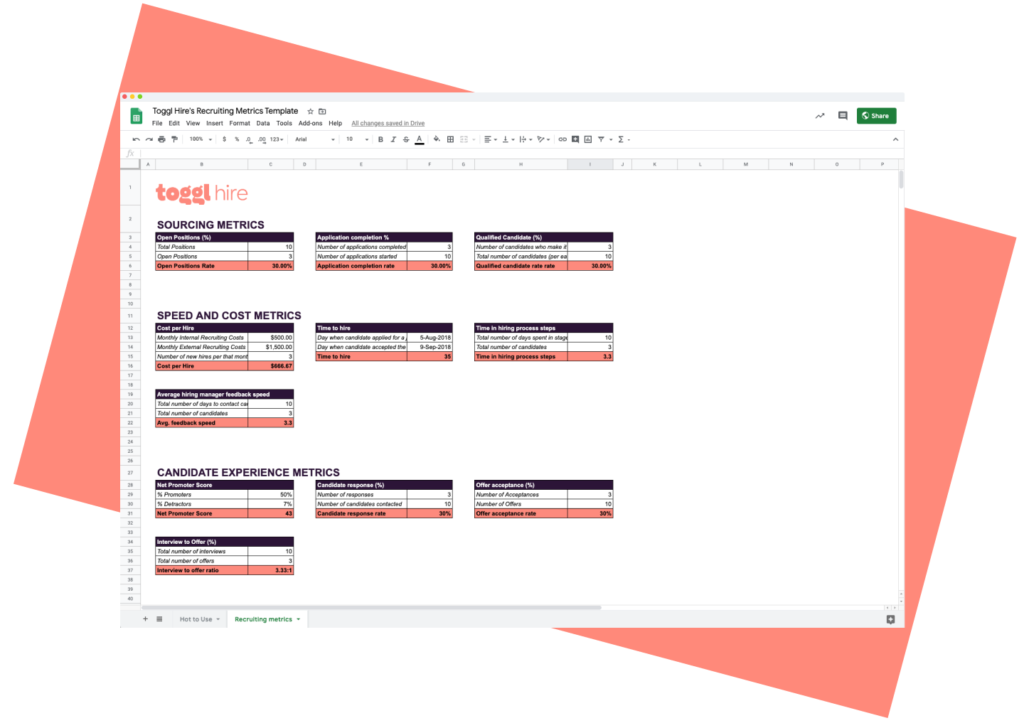Recruiting metrics calculation template
First off, to make your life easier, we’ve put together an easy-to-use recruiting metrics template that includes pre-filled formulas for calculating all the recruiting KPIs we’re going to discuss in this article. To use the template, simply download a free copy of the template, and fill it in with your own recruiting numbers.

But now, let’s dig into 18 recruiting metrics that every hiring team should track in 2023. Click on the metric below to jump right to this part of the article:
Sourcing metrics:
- Percentage of open positions
- Number of applicants
- Application completion rate
- Qualified candidate rate
Speed and cost metrics:
Candidate experience metrics:
- Candidate experience (Net Promoter Score)
- Candidate response rate
- Offer acceptance rate
- Interview to offer ratio
- Candidate withdrawal reasons
Hiring quality metrics:
Employee metrics:
SOURCING METRICS
1) Percentage of open positions
Let’s start off with the basics. How many open positions do you currently have?
While this recruiting metric may first seem like it won’t provide any valuable information, it is still wise to keep track on it. Having a high number of open positions could mean that:
- there is high demand or low supply of labor
- your business is under-performing or you have low retention rates
- your business is experiencing growth
You can track this recruiting metric across time to identify seasonal patterns. Larger organizations can analyze by the department to better determine recruitment budgets.
How to calculate open position rate?
Open positions (%) = (number of open positions / total number of positions) x 100
2) Number of applicants
Before getting into more complicated recruiting metrics, here’s another basic yet important one.
The number of applicants won’t tell you anything about how many suitable applicants you are attracting. But, it will tell you about the popularity of a role and how well you are marketing it.
Sometimes you may want to reduce the total number of applicants. That’s why the number of applicants is a useful recruitment metric to track.
Having too many candidates can show that your job description is too vague or the salary is too high.
That’s why the number of applicants is a useful recruitment metric to track.
3) Application completion rate
How many of those who start your application process end up submitting an application? If you have large numbers failing to complete, there is a problem in there somewhere. Possible issues include:
- the application process is too long or too complex
- technical problems (e.g. not optimized for mobiles)
- applicants asked for sensitive or irrelevant information
You can break this recruiting metric down by application stage to find if any stage has a larger quit rate.
How to calculate application completion rate?
Application completion ratio (%) = (number of applications completed / number of applications started) x 100
PS! If you’re using Toggl Hire performance-based hiring software to screen your candidates, you’ll automatically get a detailed overview of your application completion rate.
4) Qualified candidate rate (per sourcing channel)
Knowing how many applicants you have is often not enough. You need to know where your high-quality candidates are coming from.
You’re (hopefully) advertising through multiple channels – agencies, job boards, social media, your own newsletters or website. You need an ATS that can break down not only how many applicants come through each channel, but how many make it to the next round. Understanding this information will help you plan and budget for future campaigns, maximize the most effective channels and eliminate any that aren’t working.
If, for example, you get 100 candidates from a paid ad on a job board but only two of them are qualified, whereas you get 20 candidates through free social media advertising and 8 are qualified, you’ll have evidence that social media is a more effective tool. Knowing this could help you save a lot of money.
Having data that shows total applicants is more of a vanity metric – you want something that tells you about quality rather than quantity.
If you find yourself with low numbers of qualified candidates, it can highlight many things, like:
- the job description is not accurately detailing the skills needed for the role
- the job is being advertised through the wrong channels
- the way the job is being advertised is attracting the wrong type of candidates
All these things are quite easily fixed with a few minor tweaks.
How to calculate qualified candidate rate?
Qualified candidate rate (%) = [number of candidates who make it past the initial screening stage (per each sourcing channel) / Total number of candidates (per each sourcing channel)] X 100
SPEED AND COST METRICS
5) Cost of hire
Knowing the cost of hiring a new employee is the basis for planning your recruiting budget. Luckily, most companies are calculating this recruiting metric. However, very few do it the right way.
To know how much you really pay for hiring a new employee, it is important to include ALL associated internal and external costs. These include:
- advertising costs (job boards, etc.)
- administration costs
- labor costs (time spent by recruitment staff from writing the job description to
- conducting interviews)
- candidate expenses
- background checks
- productivity losses incurred by post being vacant
- any other associated costs
If your costs are high, you can look for ways to reduce them, e.g. by advertising through cheaper methods, or by speeding up the pre-screening phase with cost-effective skills tests.
How to calculate the cost of hire?
Cost of hire (€/month) = (Monthly internal recruiting costs + monthly external recruiting costs) / number of new hires per that month
6) Time to hire
The time to hire is simply the amount of time it takes to get an employee on board. This includes everything from the time the job ad goes live until the time a suitable candidate is confirmed in post.
You can measure this recruitment metric in a total number of days. If you want more in-depth understanding, you can also break it down in following ways:
- the time between when a candidate first makes contact and when they are hired
- the time it takes for the candidate to actually start the role
- average time to hire a number of different positions
- differences in time to hire between different positions
This is a useful recruitment metric because it can help you identify if and when your hiring processes might be slow.
Avoiding slow hiring is important for two reasons. Firstly, it saves money in admin costs and prevents you from having unfilled vacancies for long periods. Secondly, it can help improve your candidate experience. Research has shown that candidates can be put off by lengthy application processes.
If your recruiting process isn’t the quickest right now, don’t worry, you’re not alone. Monese was faced with the same issue but managed to reduce their time to hire by 86%. If they can, you can too!
How to calculate the time to hire?
Time to hire (in days) = Day when candidate accepted the offer – Day when candidate applied for a job
7) Time in hiring process steps
This recruiting metric is a breakdown of the various stages that make up the total time to hire. Using your application tracking system (ATS), you should be able to see the amount of time spent by candidates in each of the hiring process steps.
This is useful for identifying bottlenecks in the hiring process. If your total time to hire is excessive, you can analyze the different steps to see where the problem is.
How to calculate time in hiring process steps?
Time in each hiring stage (days) = total number of days spent in stage by all candidates / total number of candidates
8) Hiring manager feedback speed
This is how quickly the hiring manager contacts candidates after the interview. Ideally, this should occur within 2-3 days of the interview. Any longer risks losing the successful candidate or creating a bad impression.
The last thing you want is candidates chasing you up because they don’t want to be kept in limbo. This could impact on the candidate experience scores. Tracking the feedback time and having a deadline will stop things getting out of hand.
How to calculate feedback speed?
Feedback speed (days) = total number of days to contact candidates after interview / total number of candidates
CANDIDATE EXPERIENCE METRICS
9) Candidate experience (Net Promoter Score)
Candidate experience has grown in importance in recent years and is now a key part of recruitment analytics. You can measure candidate experience through a satisfaction survey of all candidates. A common method is the Net Promoter Score.
Candidates are asked ‘How likely are you to recommend this experience to a friend or colleague on a scale of 1-10?’ You then subtract the percentage of 9-10 scores (promoters) from the percentage of 1-6 scores (detractors) to give you a total score between -100 and +100.
Psst! Did you know you can improve your candidate experience score with Toggl Hire? 90% of our test takers would recommend our skills tests to a friend.
How to calculate Candidate Experience Net Promoter Score?
Net Promoter Score = % Promoters – % Detractors
10) Candidate response rate
If you’ve reached out to candidates through email, phone call, etc. track how many responses you get. Your candidate response rate is the number of candidates who follow up or respond to your attempts to contact them. This can be measured as:
- number of candidates replying to an email
- number of candidates who follow up on an email and take the application to the next stage
- number of candidates who call back when you leave a voicemail
- number of candidates who follow up on a phone call and progress the application
You can use this recruitment metric to find the best channel when using personal contact. It can also be used to identify a poor recruiting pitch if hardly anyone is responding.
How to calculate candidate response rate?
Candidate response rate (%) = (number of responses / number of candidates contacted) x 100
11) Offer acceptance rate
What percentage of candidates that are offered a role accept the position?
This recruiting metric can tell you valuable things about the overall success of your recruitment process as well as your candidate experience. If the rate is low, something’s going wrong along the line and you need to rectify it.
Unfortunately, this metric alone won’t tell you exactly what the problem is. You’ll need to dig a little deeper to get the answers.
Maybe the salary or incentives weren’t competitive enough? Perhaps candidates are deterred by a lengthy recruitment process? Or maybe something is wrong with the interview format?
If lots of candidates refuse your offer, ask them what’s the cause of their refusal. Remember, you can’t improve what you can’t measure.
How to calculate offer acceptance rate?
Offer Acceptance Rate (%) = ( Number of Acceptances / Number of Offers ) x 100
12) Interview to offer ratio
Your interview to offer ratio is how many interviews you are carrying out per hire. It is a similar recruitment metric to the offer to acceptance ratio.
You should be averaging about 1-3 interviews per hire. More than that and you start to waste valuable resources.
Are you interviewing large numbers of candidates for roles? It could be that earlier hiring processes need tightening up. It could also mean that the hiring manager is too strict or indecisive.
How to calculate interview to offer ratio?
Interview to offer ratio = total number of interviews / total number of offers
13) Candidate withdrawal reasons
Do you get a lot of candidates dropping out at the interview stage or turning down job offers?
You can use a recruitment metric to identify what the barriers are. Common reasons for withdrawal include too much travel, low salary, and better job offers elsewhere.
Knowing why applicants quit can help you spot trends and improve your hiring processes. You can assess with a questionnaire asking for reasons and logging responses. This can have pre-selected responses to choose from to make it easier for the candidate.
HIRING QUALITY
14) Quality of hire
Recruiting metrics don’t stop at the end of the recruitment process. You need to track how well those you hire perform.
Reviewing the first-year performance of all new recruits will let you know how well you are hiring top quality talent. It will also flag up any under-performers.
The US Department of Labor calculates that bad hires can cost around 30 percent of the first-year salary. If your hiring practices are causing poor selection choices, you’ll need to sort this out. Calculating the quality of hire depends on what factors make up a good employee for the post.
You’ll need to:
- decide on a few important factors (e.g. job performance score, cultural fit)
- give a score for each (e.g. 1-100)
- divide by the number of factors used to give an overall quality score.
How to calculate the quality of hire?
You can use quality of hire scores to calculate overall hire success ratio. To do this, decide on a quality of hire threshold score that equates to a good quality hire (e.g. 65/100).
Quality of hire score = (Job quality indicator 1 + job quality indicator 2) / # of job quality indicators
15) Internal vs external hires
Are you getting better results from promoted employees or those hired from outside? Your recruitment analytics on quality of hire can look at the effectiveness of both internal and external hires.
Many companies look to hire internally first as it’s cheaper, faster and easier. But do they produce better results? Relying on internal hiring can limit development as fewer new perspectives are introduced. It also limits diversity.
How to calculate the quality of internal vs external hires?
You can compare the quality of internal and external hires by using average scores on a quality of hire assessment, or by percentage of hires that score over a set figure.
16) Hiring manager satisfaction
How satisfied is the hiring manager with the quality of the candidates?
This recruiting metric adds a subjective element to the quality of the recruitment process. It can help flag up problems such as getting good highly-skilled candidates who are not a good cultural fit.
How to calculate hiring manager satisfaction rate?
You can calculate this with a satisfaction survey for the manager to complete (rating the quality of applicants). From there, you could use this formula:
Hiring manager satisfaction ratio = number of candidates interviewed / number of candidates hiring manager is satisfied with
EMPLOYEE METRICS
17) Employee referrals
Employee referrals are candidates referred by existing employees of the company. This is useful in recruitment analytics as studies show benefits of hiring referred candidates.
For example, a Jobvite study found that employee referrals:
- have greater hire conversion rates
- produce faster hires (29 days compared to 39 for job boards and 55 for career sites)
- lower turnover rates, with 47 percent staying over 3 years
How to calculate employee referrals?
1) Employee referrals (in terms of job candidates for a role) = (total number of applicants / number of applicants referred by employees)
2) Employee referrals (in terms of those hired) = (total number of employees / number of employee referrals hired)
18) Employee retention rate
Last on the list is employee retention rate.
High staff turnover is a costly problem. Studies show that turnover costs can be higher than 200% annual salary costs for some highly-skilled work.
If you are experiencing high employee turnover, you’ll want to sort the problem out quickly. The problem could be with you as an employer, or it could be that you’re attracting less committed applicants to the role.
How to calculate employee retention rate?
Employee retention rate (%) = [No. of employees at end of period / No. of employees at start of period] x 100
Ps! Don’t forget to download a free copy of the recruiting metrics calculation template! Get your free copy here.


